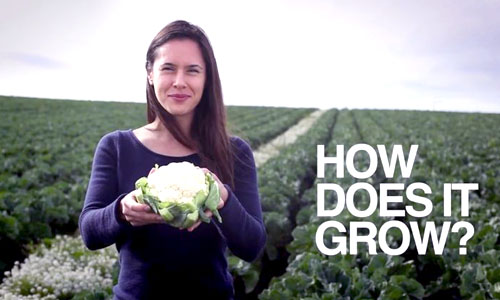

That headline might seem sensationalist. You might be expecting to read about vegetable producers dipping your food in bleach. This is not the case. Yet the story is still shocking—and in the new episode below of How Does it Grow?, we reveal the labor-intensive method farmers go through to prevent their cauliflower from turning yellow.
[vimeo https://vimeo.com/105560277 expand=1]
As cauliflower matures in the field, the sun naturally alters the color of the head. If it is exposed too long to the sun, the curds turn a dull yellow. This doesn’t affect the taste of the vegetable—in fact, it likely produces more phytonutrients—but it does affect our desire to buy it.
Somewhere along the way, consumers have come to believe that a good, healthy head of cauliflower should be white. We’re not talking about heirloom varieties that come in dazzling colors like orange and purple, but your standard head of cauliflower that arrives in our supermarkets white as snow.
It may have to do with our tendency to equate the color white with cleanliness or with our demand for blemish-free, perfect-looking produce (and what better color to advertise perfection than white?). But the result is a harsh reality few of us realize: thousands of cauliflower heads get left to rot in the field each year for one reason only—we won’t buy them.
Many of us think of food waste as the bread we don’t eat from the complimentary bread basket at a restaurant or the leftovers we throw away at the end of the week. But it also encompasses the good food left in the field unpicked because farmers know it won’t meet distributors’ standards as dictated by us, the consumers.
When we set out to film our latest episode of “How Does it Grow?,” a series that tells the stories of our food from field to fork, we didn’t expect to uncover a story about food waste. But this, we’ve learned, is what happens when we reconnect ourselves to the sources of our food. A humble cauliflower can inform us of our critical role in an interconnected food system.
The next time you’re at the grocery store, give that cauliflower with a touch of yellow a second look.
YOU MIGHT ALSO LIKE
Tell Starbucks to Serve Only Organic Milk From Cows Not Fed GMOs

 233k
233k  41k
41k  Subscribe
Subscribe 